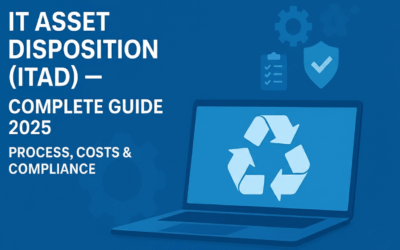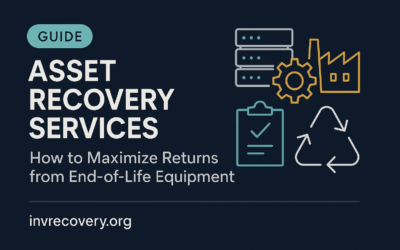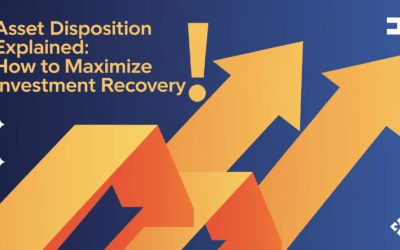
Creating An Effective Investment Recovery Department: Organizational Models That Work
In today’s competitive world, every business is trying to look for ways to manage its assets better and increase ROI. One area that does not get much attention but has a lot of potential is the investment recovery (IR) process, which is the recoverable process value from surplus idle and obsolete assets. Whether they are active surplus machinery, inventory, or retired IT equipment, effective management of surplus can benefit a business on a larger scale.
Setting up a well-organized investment recovery department guarantees that these assets neither sit idle nor lose value. They can rather be assessed and either reassigned, resold, or cycled through in a way that optimizes recovery while minimizing waste.
Why Structure Matters in Investment Recovery
Surplus assets can drain company resources without notice. Having no strategic plan means items may rot in storage, depreciate in value, or be sold for far less than their worth. This can lead to compliance issues and missed tax deductions. An uncoordinated approach to asset mismanagement results in lost opportunities combined with hidden costs.
The outcome of companies that treat investment recovery as an intermittent activity is inconsistent. On the other hand, having an investment recovery team allows the proactive management of assets, which includes identifying and collaborating on disposition strategies for surplus assets. Adopting this principle shifts IR from a cost center to a revenue-generating resource.
From defined, cohesive roles and strong team collaboration arise process streamlining, enhanced accountability, and informed decision-making. These improve overall compliance and, in combination with better coordination of performance tracking, lead to improved recovery rates and cost-saving metrics.
Core Functions of an Investment Recovery Department
Surplus assets can drain company resources without notice. Having no strategic plan means items may rot in storage, depreciate in value, or be sold for far less than their worth. This can lead to compliance issues and missed tax deductions. An uncoordinated approach to asset mismanagement results in lost opportunities combined with hidden costs.
The outcome of companies that treat investment recovery as an intermittent activity is inconsistent. On the other hand, having an investment recovery department team allows the proactive management of assets, which includes identifying and collaborating on disposition strategies for surplus assets. Adopting this principle shifts IR from a cost center to a revenue-generating resource.
Valuation and Internal Reallocation
After identifying an asset, the next critical step is discovering how to evaluate it.
Contemplation covers issues like:
- Market demand
- The asset’s age and condition
- Comparable resale values
- Depreciation and book value
- Repair costs or upgrade potential
- Decision-making, pricing, and reuse all largely depend on value estimation.
Internal allocation frequently results in the lowest costs. If the asset can be used by a different department, their organization saves amounts on new procurements and makes cuts to wasteful spending. As an example, there is a surplus of laptops in the marketing department, and those can be handed down to a newly hired sales team.
A strong IR team must reach across departments to facilitate the organizational flow that needs to happen and have the visibility that allows them to seamlessly use needed position assets.
Resale, Recycling, or Disposal
After an appraisal has taken place and after decisions on internal transfers have all been allocated, a disposition approach must be selected:
Resale: Potential reselling of an asset through:
- Online Shops
- Auction Websites
- Private Sales
- Liquidation Brokerage
For resale, a strategy needs to be implemented that reduces costs and holding time while maximizing ROI.
Recycling: For both broken and outdated files, such as obsolete IT appliances, recycling supports corporate sustainability objectives. The IR department has to work with designated certified recyclers or other certifying bodies for environmental compliance.
Disposal: Applies when an asset lacks any market value, and if it does, the asset poses a danger. Secured compliant disposal includes:
- No confidential or branded materials
- Destruction of Hazardous Waste based on EPA, OSHA, or international guidelines.
Every channel has to be evaluated based on financial explorations, environmental effects, and risks associated with legal complications.
Compliance and Documentation
Compliance, as we would all realize by now, goes beyond a mere regulatory box tick; it can protect a company’s image and mitigate reputation risk.
Every single transaction made has to comply with the following procedures defined by the IR department:
- Approval workflows and controls at the organizational level
- Environmental laws and regulations (e-waste, chemicals, and machinery)
- Data protection and privacy legislations concerning IT assets, particularly regarding data erasure (ensuring wiping of all sensitive data)
- Financial and tax reporting requirements
- Health and safety laws and regulations about the control or management of hazardous materials’ waste
- Compliance record keeping covers accurate documentation of:
- Methods and dates for outside asset auctioning
- Custody chain
- Buyer information
- Financial information (for revenue recovered or costs avoided)
Audits involve checks of significant details, confirming what is insured under insurance policies, and monitoring valuable assets. All these procedures make it easier to manage claims, ease proper documentation, and depict cost savings or avoided losses. Effective documentation makes processing and tracking critical insurance-related documents easy.
Reporting and Analytics
This function extracts operational data and turns it into strategic insights. An integrated revenue (IR) department does not just relocate assets for the sake of relocating them. A more advanced department analyzes and improves these processes on a continuous basis.
In this department, the key responsibilities include:
Reporting on:
- Recovery Value By Asset Type
- Time-to-sale metrics
- Internal reallocation savings
- Diverted landfill waste
- Cost avoidance of useless or obsolete materials
- Reuse or recycling of materials
- KPI tracking for:
- Recovery Rate KPI (the percent of asset value recouped)
- Time-To-Recovery KPI (the average time between recognition of surplus and disposition)
- Compliance scorecards
- The percentage of assets that are reallocated internally.
Analyzing recurring surplus sources or inefficient repetitive practices for trend analysis towards betterment of continual process improvement.
The use of advanced analytics facilitates the organization’s aim of demonstrating value, which helps in convincing executive leadership, thus gaining continual backing and funding for enhancements to the integrated revenue program.
Common Organizational Models That Work

Different businesses entail varying scopes of structural organizational hierarchy depending on their size, functions, operations, and strategic goals. Here are three effective models:
A. Centralized Model
Also Known As: All IR services are handled by a single, central unit that manages mandates, procedures, and asset recovery for the whole organization.
Benefits:
- Powerful control and homogenize handling of the functions.
- Stronger forces for negotiating the disposal with buyers.
- Reduced operational costs for the sale of goods and disposal.
- Centralized data analysis and compliance supervision.
Best Fit: Large corporations with several sites that maximize advantages from centralized control and standardization.
B. Decentralized Model
Meaning: Every business unit or site controls its own IR activity with little or no control from the center.
Benefits:
- Greater Flexibility and Autonomy
- Improved control and management at the local levels
- Enhanced local vendor relationships and knowledge
Best Fit: Multinational or international companies with important local flexibility and responsiveness.
C. Hybrid Model
Definition: Integrates a central strategic unit with localized execution. Central units formulate policies and offer tools; local units handle daily recovery operations.
Benefits:
- Flexible compliance of policy with operational mandate.
- As much as needed, standardization without slowing local actions.
- Best for a variety of operations and locations.
Best Fit: Medium to large organizations that need governance and agility.
Key Roles in an Effective Investment Recovery Team
A sophisticated IR team operates effortlessly with an Investment Recovery Manager, an Asset Disposition Specialist, a Compliance Officer, an Inventory or Data Analyst, and Cross-Functional Liaisons.
- Investment Recovery Manager: Strategizes on policies and performance management. Drives investment recovery strategies to meet overarching corporate objectives.
- Asset Disposition Specialist: Manages the contracts for the sale, donation, or recycling of assets obligatory for business operations. Sells assets and negotiates terms with clients.
- Compliance Officer: Ensures all activities are within the legal, environmental, and internal compliance thresholds. Conducts risk and other regulated reporting.
- Inventory/Data Analyst: Monitors the assets, updates the databases, and offers invaluable reports to foster informed decisions.
- Cross-Functional Liaisons: Work with other stakeholders like legal, finance, operational, and procurement aides to classify and categorize surplus, then optimize recovery procedures.
Technology and Tools to Support the Organization
Today’s technology promotes efficiency, communication, and visibility in investment recovery.
- Asset Management Systems: Surplus inventory can be tracked and managed with ERP systems or Inventory Recovery-specific platforms.
- Integrated Communication Tools: Cross-departmental software improves communication, which increases visibility and allows better decisions to be made regarding assets.
- KPI Dashboards: KPI Dashboards provide a method of tracking recovery rate, time-to-sale, recycled assets volume, and total avoided cost to evaluate progress and direct enhancements.
Best Practices for Building or Restructuring Your Department
Thinking about creating or improving your Investment Recovery (IR) function? These strategic steps will help you establish a department that saves costs and operates efficiently:
- Conduct an Audit
Analyze the process flow of surplus assets within your organization. Determine delays or gaps in processes. Pay attention to problematic accounts or repetitive issues across regions. - Align Goals with Corporate Strategy
Your IR objectives should reflect firm priorities: cost reduction, green initiatives, digital transformation, etc. If going green is one of the firm goals, also promote recycling and measure landfill diversion. - Train and Standardize
Teach your staff compliance, valuation, and resale. Implement a single policy that covers all departments. Uniform policies facilitate quicker execution and fewer inaccuracies. - Measure and Adapt
Focus on uncomplicated metrics such as recovery rate or sale time. Spend time on your numbers, improve weak areas, and adjust “what’s working”. Rules are only effective if you adapt them to data.
Adhering to these steps positively impacts how your IR team operates. Enable better efficiency and profitability aligned with the organization’s growth.
Conclusion
An efficiently organized investment recovery department is an operational necessity and a strategic advantage. A company can convert surplus into savings and profits with the right organizational model, defined roles, tools, and best practices. Investment recovery has the potential to become a true profit center. Start analyzing your current structure; pinpoint where you’ll make improvements, and build a team that has clear, measurable value. Implement these changes with proper investment recovery planning, and you could transform the department into a core profit driver within your organization.



